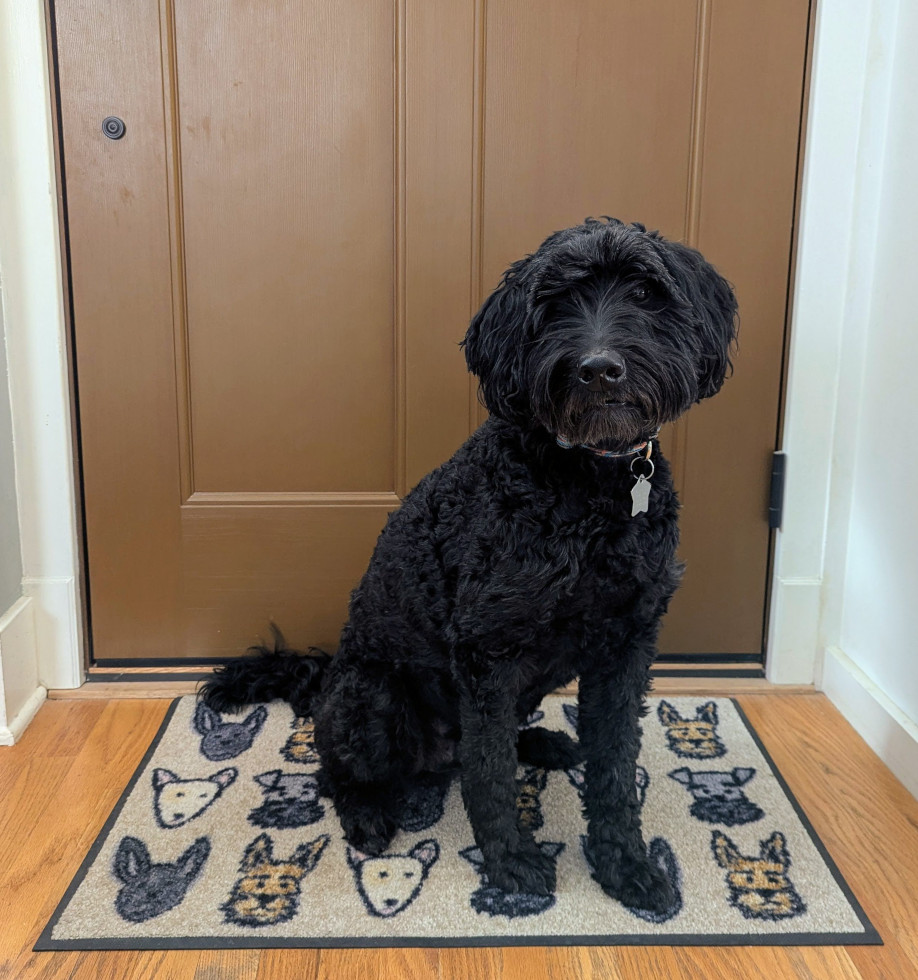The Off-Duty Hack:
Taming Front Door Chaos

For many dogs, the front door is a hot spot. It may be an exciting place (hooray, guests!) or a scary one (yikes, strangers!). Either way, you're not alone if your dog struggles with overarousal or fear whenever someone knocks or the doorbell rings. This is especially true for pandemic puppies who missed out on learning that new people coming into the house isn't a big deal.
It's been theorized that humans intentionally and selectively bred the barking response into dogs to provide an early alert system for potential intruders and to safeguard livestock. In fact, compared to wolves, foxes, jackals, and dingoes, domesticated dogs are an extremely noisy lot.
But your guests probably don't love being rushed at by a barking or jumping dog when they come over. So if the sound of knocking or the doorbell ringing sends your dog into a tizzy that further escalates as guests step through the door, here’s a solution that doesn’t require hours and hours of training.
Dogs, like kids, need house rules - and one of these rules is that barking, jumping, or being a nuisance at the front door is not permitted. This is especially important if your dog is anxious or fearful around new people, as stress about strangers entering the home can potentially escalate into a snap or bite.
The goal is to establish a predictable routine so that your dog knows what to expect every time guests arrive. In short, you are relieving your dog from the responsibility of policing guests - in effect, putting them "off-duty" - and instead providing them with a positive and relaxing experience.
The off-duty hack is an approach designed by ethologist and dog trainer Kim Brophy. It is easy to implement and very effective for helping dogs with big feelings about new people walking into your home. This protocol works equally well for enthusiastic dogs who want to jump and lick as well as for fearful dogs or those that may be guarding you or your house. It can be used with strangers, workers in the home, or guests your dog just gets too happy about.
Of course, you can opt for mat training and teach your dog to stay on a mat or their bed whenever guests arrive, but I have found that many dog guardians prefer a simpler solution. And for most of us, it’s easier to control the environment than to control our dog. The off-duty hack is a hands-off method for helping your dog make positive associations with the front door while also lessening the stress or excitement often associated with new people coming inside.
- Create a designated area for your dog to go to before guests walk through the door. Ideally, this will be an area separated by a baby gate or an X-pen with a comfy dog bed, water, and toys. Your dog should be able to see the house guests but not be near the door or right in the center of the activity. For open floor plans, you may need to use a secure tether attached to your dog's harness, again with your dog away from the action but where they can still see what is happening. This setup allows the dog to observe the guests rather than being sequestered behind a closed door.
- When the doorbell rings or someone knocks, immediately (and before opening the front door), bring your dog into their off-duty space, latch the gate, and give them something fabulously yummy. This should be a special, long-lasting treat or chew they only get when guests arrive, such as a meaty bone, a tripe-filled frozen Kong, etc. You want it to be something that makes your dog go, "Wow, every time someone new walks through the front door, I get that!?" It's okay if your dog is not interested in the special chew the first few times you practice this; give it to them anyway.
- Instruct your guests not to interact with your dog as they enter the home. Ignore any barking at this point. There is no need to shush them, toss treats, or say their name.
- Your dog may come out and greet guests when they are calm and self-regulated. When introducing your dog to guests, use a leash to ensure control. If your dog becomes rowdy or starts barking after coming out, promptly and silently return them behind the gate. They are not in trouble - just not ready yet. Repeat as needed.
Repetition is key to reinforcing this process for your dog. While these are simple steps, this is not a one-and-done. If your dog has been rushing the door for years, you’ll need to repeat this process many times. Initially, you might start with friends coming over for a very short time and then gradually have your guests stay longer. There may also be situations when your dog has no reason to greet the guest, such as when the plumber comes over or if you have a dog that is extremely aggressive or very shy.
This hands-off method not only offers a practical solution for managing your dog's behavior at the front door but also establishes a reliable routine for everyone. By relieving your dog from the responsibility of monitoring guests and providing a positive experience, you create a more relaxed environment.
Embrace the off-duty hack to cultivate positive associations with the front door and reduce stress or excitement during new arrivals. You’ll be ensuring an enjoyable experience for you, your guests, and your dog.

